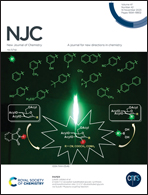Two-step separation of lignin from poplar wood powder using malic acid/choline chloride deep eutectic solvents†
Abstract
Deep eutectic solvents (DESs) have been extensively studied for lignin extraction from lignocellulosic biomass due to their easy synthesis, selective lignin dissolution, high recyclability, and other benefits. In this study, lignin in poplar wood was extracted using DESs composed of malic acid (Mal) and choline chloride (ChCl). A two-step treatment approach using DESs was proposed in order to enhance the lignin separation capability of DESs under mild conditions and achieve cellulose purification. The impacts of the Mal/ChCl molar ratio, reaction temperature and time on lignin extraction were examined. 75.3% of lignin was separated from poplar wood using Mal/ChCl (2 : 1) DESs at 120 °C for 4 h. Notably, after two-step DES treatments, 86.9% of lignin was removed, and the delignification efficiency was 21.7% higher than that by one-step treatment at the same temperature and time. Also, the lignin dissolved in DESs was regenerated and characterized by Fourier transform infrared spectroscopy (FT-IR), gel permeation chromatography (GPC), and heteronuclear single quantum correlation (HSQC) spectroscopy. The results suggested that the regenerated lignin has low molecular weight with the β-O-4′ bond eliminated, which could be beneficial for the subsequent modification and development of lignin-based biofunctional materials.



 Please wait while we load your content...
Please wait while we load your content...